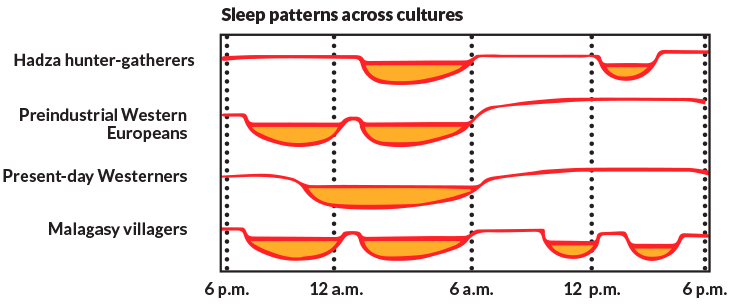Analyze This: Sleep patterns vary widely across the world
Keeping a consistent sleep schedule is part of getting a good night’s sleep

Getting a good night’s snooze is important, but what that looks like can vary greatly between cultures.
diego_cervo/iStockphoto
Sleep is important. When someone doesn’t get enough zzzzz’s, it becomes harder for them to learn new things, pay attention to their surroundings and concentrate on schoolwork. With too little sleep, people tend to be more inclined to choose unhealthy foods. Behind the wheel of a car, they might even make unsafe moves.
But what’s the most important aspect of sleep? Is it the quality of shuteye, the amount of dream time or a consistent sleep schedule (each day going to bed and rising at about the same time)? The answer is all of the above. In fact, recent data suggest that keeping a consistent sleep schedule might be every bit as important as getting the right amount of quality sleep.
Interestingly, not everyone in the world keeps to the same types of sleep schedules. In a pair of recent studies, scientists looked at the sleep patterns of four groups of people. The Hadza are hunter-gatherers that live in Tanzania, a nation in East Africa. The Malagasy live in villages on the large island nation of Madagascar, off Africa’s lower East Coast. Both groups live without electricity. These people were compared to those living in the West (places like the United States and Europe) as well habits in Western Europeans who lived before the Industrial Revolution, some 200 to 500 years ago.

On average, modern-day adults in Western nations sleep around 7 hours each night. Both the Malagasy and Hadza adults sleep slightly less than that, on average. This might be, in part, because the non-Western villagers spend more of their days in natural sunlight. Also, they are exposed to less blue light (from indoor lighting and computer screens), which can confuse the body’s internal clock. Napping once or twice a day may also have some effect. Hadza adults average 47.5 minutes of daily napping; Malagasy villagers, on average, nap 7.5 minutes more than that each day. Naps were usually taken during the hottest hours of the day.
Except for the naps, the Malagasy villagers’ sleep pattern is very similar to that of preindustrial Western Europeans. In both cases, adults went to sleep a little after 6 p.m. Then they slept in two shifts. The first shift ended around midnight. Then, after remaining up for an hour or so, they would fall back to sleep again.
By comparison, present-day Westerners (such as adults working 9 to 5 jobs in the United States) typically go to sleep just before midnight and get up around 6 a.m. And no mid-day naps for the majority of them!
Data Dive:
The National Sleep Foundation recommends that children from the ages of six to 13 get nine to 11 hours of sleep each night. The recommendation for teens from 14 to 17 years old is eight to 10 hours of shuteye each night. How much sleep do you think you get per night on average? How does this compare with the recommendations for your age group?
Now, let’s gather some data! Record when you go to sleep and how much sleep you get each night for a week. On average, is this more or less sleep than you thought you were getting? How consistent is your sleep schedule? Did it change on the weekend? How might this change if you tracked your sleep for a month?
Think about the adults that you know. Do you think that their sleep schedule is similar to the “present day Westerners” in the graph above? Can you think of other situations, jobs or schedules that would change someone’s sleep schedule?
How could this graph be improved? Is there another way to graph these data?
Analyze This! explores science through data, graphs, visualizations and more. Have a comment or a suggestion for a future post? Send an email to sns@sciencenews.org.







